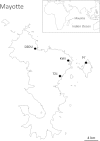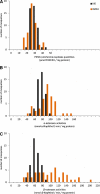Insecticide resistance in disease vectors from Mayotte: an opportunity for integrated vector management
- PMID: 24984704
- PMCID: PMC4094441
- DOI: 10.1186/1756-3305-7-299
Insecticide resistance in disease vectors from Mayotte: an opportunity for integrated vector management
Abstract
Background: Mayotte, a small island in the Indian Ocean, has been affected for many years by vector-borne diseases. Malaria, Bancroftian filariasis, dengue, chikungunya and Rift Valley fever have circulated or still circulate on the island. They are all transmitted by Culicidae mosquitoes. To limit the impact of these diseases on human health, vector control has been implemented for more than 60 years on Mayotte. In this study, we assessed the resistance levels of four major vector species (Anopheles gambiae, Culex pipiens quinquefasciatus, Aedes aegypti and Aedes albopictus) to two types of insecticides: i) the locally currently-used insecticides (organophosphates, pyrethroids) and ii) alternative molecules that are promising for vector control and come from different insecticide families (bacterial toxins or insect growth regulators). When some resistance was found to one of these insecticides, we characterized the mechanisms involved.
Methods: Larval and adult bioassays were used to evaluate the level of resistance. When resistance was found, we tested for the presence of metabolic resistance through detoxifying enzyme activity assays, or for target-site mutations through molecular identification of known resistance alleles.
Results: Resistance to currently-used insecticides varied greatly between the four vector species. While no resistance to any insecticides was found in the two Aedes species, bioassays confirmed multiple resistance in Cx. p. quinquefasciatus (temephos: ~ 20 fold and deltamethrin: only 10% mortality after 24 hours). In An. gambiae, resistance was scarce: only a moderate resistance to temephos was found (~5 fold). This resistance appears to be due only to carboxyl-esterase overexpression and not to target modification. Finally, and comfortingly, none of the four species showed resistance to any of the new insecticides.
Conclusions: The low resistance observed in Mayotte's main disease vectors is particularly interesting, because it leaves a range of tools useable by vector control services. Together with the relative isolation of the island (thus limited immigration of mosquitoes), it provides us with a unique place to implement an integrated vector management plan, including all the good practices learned from previous experiences.
Figures




References
-
- Grjebine A. Rapport sommaire sur la première étude des moustiques vecteurs de la filariose des iles Pamandzi et Mayotte. Paris: ORSTOM; 1956.
-
- Brunhes J, Dandoy G. Géographie de la filariose de bancroft dans les iles d’Anjouan et de Mayotte (archipel des Comores) Cahier ORSTOM. 1978;15:3–15.
-
- Blanchy S, Galtier J. La filariose de Bancroft a Mayotte. Etat actuel de l’endémie filarienne et programme de lutte. Cahier ORSTOM. 1982;20:153–159.
-
- Julvez J, Mouchet J. Epidémiologie Historique de la filariose de bancroft dans les îles du sud-ouest de l’océan indien. Bull Soc Pathol Exot. 1994;87:194–201. - PubMed
-
- Galtier J, Blanchy S. Le paludisme à Mayotte et son évolution de 1976 à 1981. Cahier ORSTOM. 1982;20:145–151.
Publication types
MeSH terms
Substances
LinkOut - more resources
Full Text Sources
Other Literature Sources
Medical

